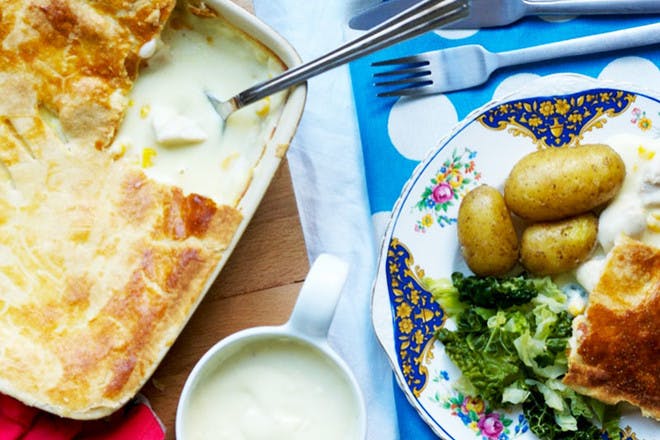A great way to save money is by using a budget meal planner; it reduces the chance of impulse buys and makes the most of the ingredients you already have. You can either follow the plan as it is, or use it as a guide and adapt it to suit your family's food preferences.
This page contains affiliate links, which means we may earn a small amount of money if a reader clicks through and makes a purchase. All our articles and reviews are written independently by the Netmums editorial team.
When you're trying to stick to a budget, meal planning and cooking at home for the family can help you save some serious cash.
What's more, it helps you make better food choices and feel fuller for longer, instead of binging on takeaway food, ready meals and snacks.
Check out our month-long budget meal plan for ideas of cheap and easy meals you can cook at home, featuring plenty of ingredients you'd have in your cupboards already, making some of these dishes free to make.
Don't forget to make large portions where possible so you can save them for leftovers or freeze the rest. That way, when plans change, you've got a meal ready to defrost.
Main meals – four week budget main meal planner
Below are recipe ideas for four weeks, you can of course adapt these any way you see fit, switch days, and add extra sides if you like:
Monday – Lentil curry (add some extra veg to the curry) with rice
Tuesday – Chilli with pasta (save leftovers for tomorrow's lunch)
Wednesday – Baked potatoes topped with leftover chilli (bulked out with a tin each of value baked beans and sweetcorn if needed)
Thursday – Super spaghetti with garlic bread and extra veg
Friday – Fish pie with carrots
Saturday – Sausages with homemade wedges and frozen mixed veg
Sunday – Chicken pasta bake
Monday – Cheesy baked tortillas with broccoli
Tuesday – Chicken casserole with rice
Wednesday – Oven omelette with salad and bread
Thursday – Keema (mince) curry (add a drained tin of chickpeas to bulk out the mince) with rice
Friday – Leek and potato soup with cheesy corn triangles
Saturday – Fish fingers/value battered fish portions with cheesy mash and frozen mixed veg
Sunday – Grilled pork chops with new potatoes and seasonal veg
Monday – Veggie chilli with value tortilla chips or rice
Tuesday – Minestrone soup and crusty bread
Wednesday – Tuna pasta bake with frozen mixed veg
Thursday – Sausage and bean hotpot with boiled potatoes
Friday – Beef burgers with homemade chips and frozen peas
Saturday – Roast chicken dinner with roast potatoes and vegetables
Sunday – Chicken and potato layer (using leftover roast chicken) with broccoli
Monday – Chickpea pasta
Tuesday – Spanish rice – add whatever meat/fish is cheap or on offer
Wednesday – Shepherd’s pie with seasonal veg
Thursday – Frittata with jacket potato and baked beans
Friday – Cowboy casserole
Saturday – Pizza topped with any leftover veg or meat you have and value grated cheese, served with pasta salad
Sunday – Tuna and tomato pasta
We recommend you keep track of your meals to avoid repetition AND it will be helpful to cut down on excessive snacking if you're trying to lose weight.
This clever notepad with shopping list and weekly menu planner is just what you need! Plus, it comes with a handy clip-on pencil and pocket for storing receipts and vouchers. You can find it here at Amazon for £7.99 .
Download a printable version of this meal planner here
Handy tips
Stock up on extras for lunches, snacks or treats
Fromage frais, yoghurt pots, salad or vegetable sticks, fresh, tinned or dried fruit, tinned rice pudding, jelly and ice cream, value crisps, biscuits etc.
Look for special offers on breads
Freeze on day of purchase and only take out what you need to defrost each day.
Homemade puddings and treats
Make a double batch and freeze half.
Batch cook
Make big one pot meals like chilli , lasagne , spaghetti bolognese or a stew , then freeze some and defrost whenever you haven't the time to cook. A slow cooker is a great way to do this.
Go meat-free a few times a week
Going veggie a few times a week is good for your health, your wallet and the environment.
Sneak in veggies in clever ways
It’s can be tricky getting the kids to eat certain foods like vegetables and fibre-rich grains, but our recipes use clever ways of incorporating them.
Make cheap healthy swaps
You can still keep the family healthy when you're on a budget; just make simple swaps like semi-skimmed milk instead of whole milk, wholegrain bread instead of white, brown pasta and rice instead of white and so on.
Buy a couple of big bags of frozen veg for the week too, instead of fresh which may go off quickly. You can always bulk out dinner with vegetables if you haven't got much meat.
Budget breakfasts, lunches and puddings
Value/special offer cereal & milk
Porridge (with chopped or mashed banana or raisins)
Toasted crumpets
Fresh or tinned fruit
Scrambled or fried egg on toast
Boiled egg and soldiers
Full cooked breakfast!
Filled pitta bread, wrap or sandwiches (check out our ideas for fillings )
Homemade or shop-bought soup with crusty bread
Value instant noodles
Value beans or spaghetti on toast
Cream cheese/pate/spread and crackers
Toasted sandwich
Hotdog in bread roll
Download a printable version of breakfast, lunch and pudding suggestions here .
More tips
- Remember that you can chop and change the day's menus around.
- If you have a veggie in the family, most of our recipes can be adapted by using a meat substitute (eg: Quorn or soya) or by adding an alternative source of protein such as eggs, cheese, beans or lentils.
- The meals work on the assumption that you have already got some of the basic ingredients such as vegetable/olive oil, stock cubes, mayonnaise/salad dressing, sauce, spreads for sandwiches, mixed herbs, chilli powder etc.
- You may well already have other staple ingredients like pasta and rice, so the price of your weekly shop may be lower than we've estimated.
- If you have any spare money, use it to stock up on staple cooking ingredients such as flour and tinned tomatoes, or buy bigger bags of rice and pasta which will last for a couple of weeks.
- You can cut the cost of your shopping further if you choose foods on special offer, cheaper cuts of meat and use dried pulses instead of tinned.
Here's what some of you are saying over on our forum:
'Firstly, I'd look through the freezer and cupboards to see what you already have – I did that last week and saved about £10 on our shopping bill' – Emily
'For food shopping, make a meal planner so you know what meals you will have for the week, then check what ingredients you already have in and write your shopping list with only the things you definitely need or shop online so that you are not tempted by going up and down the aisles' – Beth
'We have changed from branded food onto a combination of own brand and value brand products. You get to know which value products are nice, and which aren't' – Sam
You can buy whiteboard meal planners so you can plan your family's food for the week and write a shopping list. See more details here at Amazon.
Are you a ninja at food shopping on a budget? Let us know some of your tips over in the forum:
Related stories
How to feed your family for £25ish a week
CHAT: How much do you spend on food each month?







